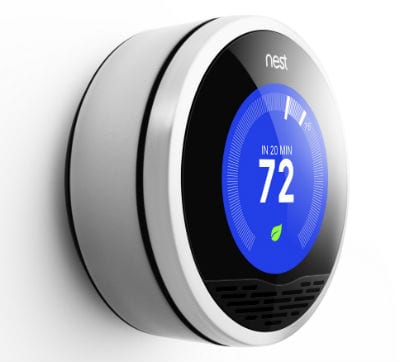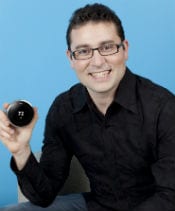Imagine an electronic device that’s billed as the future of its industry, with state-of-the-art software, sleekly designed with an LCD screen, stainless steel case, minimalist packaging and a rechargeable lithium ion battery. No, this isn’t an iPad or a MacBook. It’s the Nest Thermostat, that cool new “learning thermostat” we’ve all been reading about online.
 Wonder why it resembles that other Cupertino-designed gadget so much? Well, that’s because it is one. The Nest was designed by Matt Rogers, a former Apple employee who worked on development of the iPod.
Wonder why it resembles that other Cupertino-designed gadget so much? Well, that’s because it is one. The Nest was designed by Matt Rogers, a former Apple employee who worked on development of the iPod.
“Going back to our roots, we’re consumer-product guys who love electronics like everyday people,” Rogers said of his and co-founder (and former Apple colleague) Tony Fadell’s foray into the HVAC market. “We were looking at the home and saw an enormous opportunity to save energy — 50 percent of home energy usage is controlled by thermostats — while also improving home electronics.”
The thermostat, which sells for a cool $250, is banking on a slew of neat features not seen on your traditional thermostat: sleek user interface, an automatic temperature regulator that “learns” and adapts to your regular usage, Wi-Fi connectivity that checks weather conditions, and a mobile app to keep you connected at all times. It’s also got a proximity sensor to determine when no one is home, and all sorts of alerts and display features that show your usage and how much you’re saving. Nest sold out of its thermostats within the first 72 hours after it hit the market last October.
“We started Nest very fresh, with a lot of attention to detail,” said Rogers, Nest’s founder and vice president of engineering. “Not just the product design and UI, but we looked at how to get it on the wall, packaging, and software. We saw that we could add the most value to thermostats by having features like sensors, a bubble level for installation, and wireless connectivity. In designing it we talked to customers and found that they really appreciate all that.”
 The company is taking traditional home appliance installation and customer service and turning it on its head. Rogers said that Nest maintains a regular dialogue with its customers through emails, Facebook and Twitter, and welcomes feedback through all methods of communication. Nest’s Twitter handle already has over 4,700 followers and its Facebook page has well over 7,000 “likes” — a quick scan of both sites reveals a healthy interchange of praise, criticism, and feedback, as well as quick responses from Nest’s service team.
The company is taking traditional home appliance installation and customer service and turning it on its head. Rogers said that Nest maintains a regular dialogue with its customers through emails, Facebook and Twitter, and welcomes feedback through all methods of communication. Nest’s Twitter handle already has over 4,700 followers and its Facebook page has well over 7,000 “likes” — a quick scan of both sites reveals a healthy interchange of praise, criticism, and feedback, as well as quick responses from Nest’s service team.
Like a lot of other major appliance makers, Nest has a certified professional program by which HVAC professionals can become Nest Certified and can better access customers who need help. The thermostat is designed for the average DIYer to install, however the company acknowledges that it can get a little difficult. That’s where the professionals come in.
“Our idea was to add all these great features to the hardware so that we get them in and out faster so we get less callbacks,” Rogers told the SmartVan. “The same kind of features that make it easier to install as a DIYer make it easier to install as a professional, too.”
Nest has not revealed just how many of its thermostats have been sold since last October, however with a cool-looking product, smart software and a 21st century approach to customer service, it’s definitely on to something.

Share this: